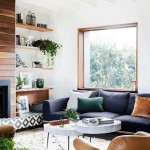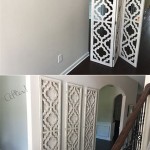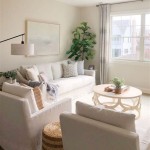How to Decorate Empty Walls: A Comprehensive Guide
Empty walls present a blank canvas, an opportunity to infuse personality and style into a living space. These expansive surfaces, often overlooked, can become focal points, adding depth, character, and visual interest to a room. Effectively decorating empty walls involves careful consideration of the room's function, existing decor, and the desired aesthetic. This article provides a comprehensive guide to transforming bare walls into attractive and engaging features.
Considering Functionality and Room Aesthetics
Before embarking on any wall decorating project, it is crucial to analyze the functionality of the room being addressed. The chosen decor should complement the room's purpose and enhance its overall atmosphere. For instance, a living room benefits from pieces that encourage relaxation and conversation, such as large-scale artwork or curated gallery walls. A bedroom, on the other hand, might be better suited for calming and serene elements like tapestries or minimalistic prints. A home office could incorporate functional elements like shelving or organizational boards.
Furthermore, it is essential to consider the existing aesthetic of the room. The color palette, furniture style, and overall design scheme should guide the selection of wall decor. A modern and minimalist space calls for sleek and understated elements, while a more traditional setting might accommodate ornate frames and classic artwork. The goal is to create a cohesive and harmonious look that integrates seamlessly with the room's existing decor.
The size of the wall is also a significant factor. A large, expansive wall can handle a substantial piece of art or a complex gallery wall, while a smaller wall may be better suited for a single, impactful piece or a series of smaller, complementary items. Scale and proportion are critical considerations to ensure that the wall decor enhances the space without overwhelming it.
Exploring Diverse Decorating Options
The options for decorating empty walls are virtually limitless, ranging from traditional artwork to more unconventional and creative solutions. Understanding the diverse range of available choices is essential for selecting the most appropriate elements for a given space.
Artwork: Paintings, prints, and photographs are classic choices for wall decor. The selection should reflect personal taste and complement the room's style. Consider the size, color palette, and subject matter of the artwork to ensure it harmonizes with the existing decor. Framing is also important; choose frames that enhance the artwork and complement the overall aesthetic of the room.
Mirrors: Mirrors are not only functional but also serve as excellent decorative elements. They can create the illusion of more space, reflect light, and add a touch of elegance to a room. Large statement mirrors, groupings of smaller mirrors, or decorative mirrors with ornate frames can all be used to enhance the visual appeal of a wall.
Shelving: Shelving provides both decorative and functional benefits. Floating shelves, wall-mounted shelves, or built-in shelving units can be used to display books, plants, decorative objects, and other personal items. Shelving can be arranged in a variety of configurations to create visually interesting displays and add depth to a wall.
Tapestries and Wall Hangings: Tapestries and wall hangings offer a textural and visually interesting alternative to traditional artwork. They can add warmth, color, and a sense of depth to a room. Consider the material, pattern, and size of the tapestry to ensure it complements the existing decor. Macrame wall hangings, woven textiles, and quilted wall art are all examples of options to consider.
Wall Decals and Murals: Wall decals and murals offer a more temporary and affordable way to add personality to a wall. Decals are available in a variety of designs, from simple patterns to elaborate scenes, and can be easily applied and removed. Murals can be custom-designed to create a unique and personalized statement.
Plants: Incorporating greenery into wall decor adds a touch of nature and freshness to a room. Hanging planters, vertical gardens, or wall-mounted planters can be used to display plants and create a living wall. Consider the light requirements of the plants and choose varieties that thrive in the specific environment.
Clocks: Decorative clocks can serve as both functional and aesthetically pleasing wall decor. Choose a clock that complements the room's style and adds a touch of personality. Oversized clocks, vintage clocks, or contemporary designs can all be used to enhance the visual appeal of a wall.
Personal Collections: Displaying personal collections on walls adds a unique and personalized touch to a room. Collections of photographs, postcards, plates, or other objects can be arranged in visually interesting displays to create a focal point. Consider the size, shape, and color of the objects being displayed and arrange them in a cohesive and balanced manner.
Decorative Plates: Decorative plates, either antique or contemporary, can create a visually striking display. Plates can be hung individually or in groupings, and can be arranged in a variety of patterns. Consider the color palette and style of the plates to ensure they complement the existing decor.
Key Principles for Effective Wall Decor
Successfully decorating empty walls requires adherence to certain key principles that ensure a balanced, visually appealing, and cohesive outcome. These principles encompass aspects of scale, composition, color, and personal expression.
Scale and Proportion: Ensuring that the size of the wall decor is proportionate to the wall and the room as a whole is crucial. A small piece of art on a large wall will appear insignificant, while a large piece on a small wall can overwhelm the space. Consider the dimensions of the wall and the surrounding furniture when selecting wall decor. A large wall might benefit from a gallery wall or a single, oversized piece, while a smaller wall might be better suited for a smaller piece or a grouping of complementary items.
Balance and Composition: The arrangement of wall decor should be balanced and visually appealing. Symmetry can create a formal and structured look, while asymmetry can create a more relaxed and informal feel. Consider the weight and visual impact of each item being displayed and arrange them in a way that creates a sense of equilibrium. Gallery walls should be carefully planned to ensure a cohesive and balanced composition. Consider using templates or mock-ups to experiment with different arrangements before hanging the artwork.
Color Coordination: The colors of the wall decor should complement the existing color palette of the room. Choose colors that harmonize with the walls, furniture, and accessories. Consider using a color wheel to identify complementary and analogous colors. Neutral colors can provide a calming and sophisticated backdrop, while bold colors can add energy and vibrancy to a room. Patterns and textures can also be used to add visual interest and depth to a wall.
Personal Expression: Wall decor should reflect personal taste and style. Choose items that are meaningful and that evoke positive emotions. Incorporate personal photographs, artwork created by loved ones, or objects collected during travels. The goal is to create a space that feels authentic and reflects the personality of the individuals who inhabit it. Do not be afraid to experiment with different styles and techniques to find what works best. Consider incorporating elements of surprise and unexpected details to add a unique and personal touch.
Creating a Focal Point: A focal point draws the eye and creates a sense of visual interest. The focal point could be a large piece of art, a statement mirror, or a gallery wall. Consider the architectural features of the room when selecting a focal point. A fireplace, a large window, or a built-in shelving unit can all serve as natural focal points. Once the focal point is established, build the rest of the wall decor around it, using complementary items to enhance its impact.
By carefully considering the functionality of the room, exploring diverse decorating options, and adhering to key principles of design, anyone can transform empty walls into beautiful and engaging features that enhance the overall aesthetic of their living space.

How To Decorate A Large Blank Wall

10 Ways To Fill A Blank Wall How Decorate Home Decor Tips Diy

Empty Wall Decorating Ideas

How To Fill That Big Empty Wall 6 Ideas For Your Blank Meredith Lynn Designs

How To Decorate A Blank Wall Gal At Home Design Studio

How To Decorate A Large Blank Wall

Sharing My Easy Decorating Tips For Filling A Blank Wall Space Floating Shelves Living Room Home Decor Trends

How To Decorate A Big Blank Wall Sanctuary Home Decor

How To Decorate A Large Wall 17 Best Decor Ideas

8 Budget Ideas For Decorating Your Blank Walls
Related Posts







